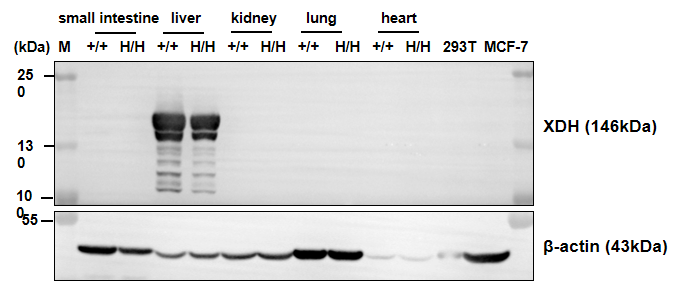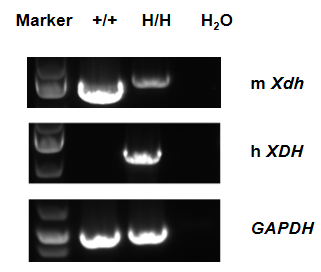中文
B-hXDH mice plus
| Strain Name | C57BL/6-Xdhtm2(XDH)Bcgen/Bcgen | Common Name | B-hXDH mice plus |
| Background | C57BL/6 | Catalog number |
112642 |
|
Related gene |
XO, XOR, XAN1 |
||
模型验证
Protein expression analysis
mRNA expression analysis
Inhibitory efficiency of the nucleic acid drugs against the XDH expression level

Strain specific XDH protein expression analysis in homozygous B-hXDH mice plus by western blot. Tissues were collected from wild-type C57BL/6 mice (+/+) and homozygous B-hXDH mice plus (H/H), and analyzed by western blot with a known cross-reactive anti-XDH antibody. The XDH protein can be detected in wild-type C57BL/6 mice and homozygous B-hXDH mice plus.

Strain specific analysis of XDH gene expression in wild-type C57BL/6 mice and B-hXDH mice plus by RT-PCR. Mouse Xdh mRNA was detectable in C57BL/6 mice (+/+) as well as homozygous B-hXDH mice plus (H/H). Human XDH mRNA was detectable only in homozygous B-hXDH mice plus (H/H), but not in wild-type mice. The results of sequencing showed that there was mouse Xdh mRNA in homozygous B-hXDH mice plus.

The inhibitory efficiency of the nucleic acid drugs against human XDH mRNA in liver tissue in B-hXDH mice plus. B-hXDH mice plus were randomly divided into three groups (n=3/group, 8 weeks old). The human XDH targeted nucleic acid drugs (synthesized according to patents) and PBS were administered to the mice individually. The nucleic acid drugs was administered in the form of PBS aqueous solution. G1 group was only treated with PBS aqueous solution. The drug dosages for all animals were calculated according to the body weight. The mice were sacrificed on day 7, and the liver tissue was collected to detect the expression level of human XDH mRNA by qPCR. (A) The schematic diagram of experimental processing. (B) The expression of human XDH mRNA in liver after treatment. The inhibition rate in the treatment group was 83.4%, demonstrating that B-hXDH mice plus provide a powerful preclinical model for in vivo evaluation of human XDH targeted nucleic acid drugs. Values are expressed as mean ± SEM.
Copyright © 2024 百奥赛图江苏基因生物技术有限公司. All Rights Reserved
备案号: 苏ICP备2021053911号-1
 苏公网安备:32068402320845号
网站建设:北京分形科技
苏公网安备:32068402320845号
网站建设:北京分形科技
 苏公网安备:32068402320845号
网站建设:北京分形科技
苏公网安备:32068402320845号
网站建设:北京分形科技






 010-56967680
010-56967680 info@bbctg.com.cn
info@bbctg.com.cn